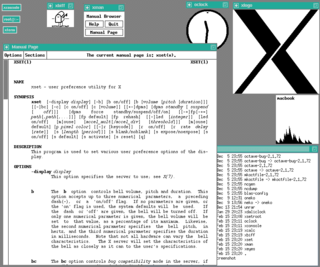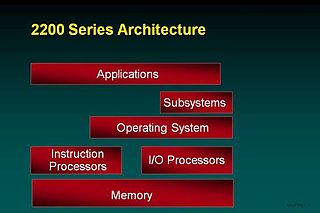| Developer | Control Data Corporation |
|---|---|
| Working state | Historic |
| Initial release | 1980s |
| Marketing target | Mainframe computers |
| Platforms | CDC Cyber 180 series and successors |
| License | Proprietary |
NOS/VE (Network Operating System / Virtual Environment) is a discontinued operating system with time-sharing capabilities, written by Control Data Corporation in the 1980s. It is a virtual memory operating system, employing the 64-bit virtual mode of the CDC Cyber 180 series computers. NOS/VE replaced the earlier NOS and NOS/BE operating systems of the 1970s.
The command shell interface for NOS/VE is called the System Command Language, or SCL for short. In order to be callable from SCL, command programs must declare their parameters; this permits automatic usage summaries, passing of parameters by name or by position, and type checking on the parameter values. All standard NOS/VE commands further follow a particular naming convention, where the form of the command is verb{_adjective}_noun; these commands could be abbreviated with the first three characters of the verb followed by the first character(s) of all further words. Examples:
| Full command | Abbreviation | UNIX command |
|---|---|---|
| display_catalog | disc | ls |
| display_working_catalog | diswc | pwd |
| change_working_catalog | chawc | cd |
| delete_catalog | delc | rmdir |
| copy_file | copf | cp |
| delete_file | delf | rm |
| create_connection | crec | telnet |
Inspired by addressing structure-members in various programming languages, the catalog separator is the dot.
Subsystems like FTP integrate into the command shell. They change the prompt and add commands like get_file. Thereby statements like flow-control stay the same and subsystems can be mixed in procedures (scripts).
Commands could take parameters such as the create_connection command:
crec telnet sd='10.1.2.3'
would connect you to IP address 10.1.2.3 with telnet service.
Telnet is a client/server application protocol that provides access to virtual terminals of remote systems on local area networks or the Internet. Telnet consists of two components: (1) the protocol itself which specifies how two parties are to communicate and (2) the software application that provides the service. User data is interspersed in-band with Telnet control information in an 8-bit byte oriented data connection over the Transmission Control Protocol (TCP). Telnet was developed in 1969 beginning with RFC 15, extended in RFC 855, and standardized as Internet Engineering Task Force (IETF) Internet Standard STD 8, one of the first Internet standards. Telnet transmits all information including usernames and passwords in plaintext so it is not recommended for security-sensitive applications such as remote management of routers. Telnet's use for this purpose has waned significantly in favor of SSH. Some extensions to Telnet which would provide encryption have been proposed.
Control Data Corporation (CDC) was a mainframe and supercomputer firm. CDC was one of the nine major United States computer companies through most of the 1960s; the others were IBM, Burroughs Corporation, DEC, NCR, General Electric, Honeywell, RCA, and UNIVAC. CDC was well-known and highly regarded throughout the industry at the time. For most of the 1960s, Seymour Cray worked at CDC and developed a series of machines that were the fastest computers in the world by far, until Cray left the company to found Cray Research (CRI) in the 1970s. After several years of losses in the early 1980s, in 1988 CDC started to leave the computer manufacturing business and sell the related parts of the company, a process that was completed in 1992 with the creation of Control Data Systems, Inc. The remaining businesses of CDC currently operate as Ceridian.

The CDC 6600 was the flagship of the 6000 series of mainframe computer systems manufactured by Control Data Corporation. Generally considered to be the first successful supercomputer, it outperformed the industry's prior recordholder, the IBM 7030 Stretch, by a factor of three. With performance of up to three megaFLOPS, the CDC 6600 was the world's fastest computer from 1964 to 1969, when it relinquished that status to its successor, the CDC 7600.
VME is a mainframe operating system developed by the UK company International Computers Limited. Originally developed in the 1970s to drive ICL's then new 2900 Series mainframes, the operating system is now known as OpenVME incorporating a Unix subsystem, and runs on ICL Series 39 and Trimetra mainframe computers, as well as industry-standard x64 servers.

A computer terminal is an electronic or electromechanical hardware device that can be used for entering data into, and transcribing data from, a computer or a computing system. The teletype was an example of an early-day hard-copy terminal and predated the use of a computer screen by decades.

The ETA10 is a vector supercomputer designed, manufactured, and marketed by ETA Systems, a spin-off division of Control Data Corporation (CDC). The ETA10 was an evolution of the CDC Cyber 205, which can trace its origins back to the CDC STAR-100, one of the first vector supercomputers to be developed.
Job Control Language (JCL) is a name for scripting languages used on IBM mainframe operating systems to instruct the system on how to run a batch job or start a subsystem. The purpose of JCL is to say which programs to run, using which files or devices for input or output, and at times to also indicate under what conditions to skip a step. Parameters in the JCL can also provide accounting information for tracking the resources used by a job as well as which machine the job should run on.
The Control Language (CL) is a scripting language originally created by IBM for the System/38 Control Program Facility and later used in OS/400. It bears a resemblance to the IBM Job Control Language and consists of a set of command objects (*CMD) used to invoke traditional programs or get help on what those programs do. CL can also be used to create CL programs where there are additional commands that provide program-like functionality

In computing, text-based user interfaces (TUI), is a retronym describing a type of user interface (UI) common as an early form of human–computer interaction, before the advent of bitmapped displays and modern conventional graphical user interfaces (GUIs). Like modern GUIs, they can use the entire screen area and may accept mouse and other inputs. They may also use color and often structure the display using box-drawing characters such as ┌ and ╣. The modern context of use is usually a terminal emulator.

The CDC Cyber range of mainframe-class supercomputers were the primary products of Control Data Corporation (CDC) during the 1970s and 1980s. In their day, they were the computer architecture of choice for scientific and mathematically intensive computing. They were used for modeling fluid flow, material science stress analysis, electrochemical machining analysis, probabilistic analysis, energy and academic computing, radiation shielding modeling, and other applications. The lineup also included the Cyber 18 and Cyber 1000 minicomputers. Like their predecessor, the CDC 6600, they were unusual in using the ones' complement binary representation.

Commodore DOS, also known as CBM DOS, is the disk operating system used with Commodore's 8-bit computers. Unlike most other DOSes, which are loaded from disk into the computer's own RAM and executed there, CBM DOS is executed internally in the drive: the DOS resides in ROM chips inside the drive, and is run there by one or more dedicated MOS 6502 family CPUs. Thus, data transfer between Commodore 8-bit computers and their disk drives more closely resembles a local area network connection than typical disk/host transfers.
SCL may refer to:

In computing, a shell is a computer program that exposes an operating system's services to a human user or other programs. In general, operating system shells use either a command-line interface (CLI) or graphical user interface (GUI), depending on a computer's role and particular operation. It is named a shell because it is the outermost layer around the operating system.

The CDC 3000 series are a family of mainframe computers from Control Data Corporation (CDC). The first member, the CDC 3600, was a 48-bit system introduced in 1963. The same basic design led to the cut-down CDC 3400 of 1964, and then the 24-bit CDC 3300, 3200 and 3100 introduced between 1964 and 1965. The 3000 series replaced the earlier CDC 1604 and CDC 924 systems.
TUTOR, also known as PLATO Author Language, is a programming language developed for use on the PLATO system at the University of Illinois at Urbana-Champaign beginning in roughly 1965. TUTOR was initially designed by Paul Tenczar for use in computer assisted instruction (CAI) and computer managed instruction (CMI) and has many features for that purpose. For example, TUTOR has powerful answer-parsing and answer-judging commands, graphics, and features to simplify handling student records and statistics by instructors. TUTOR's flexibility, in combination with PLATO's computational power, also made it suitable for the creation of games — including flight simulators, war games, dungeon style multiplayer role-playing games, card games, word games, and medical lesson games such as Bugs and Drugs (BND). TUTOR lives on today as the programming language for the Cyber1 PLATO System, which runs most of the source code from 1980s PLATO and has roughly 5000 users as of June 2020.
SCOPE is a series of Control Data Corporation batch operating systems developed in the 1960s.

NOS is a discontinued operating system with time-sharing capabilities, written by Control Data Corporation in 1975.

The figure shows a high-level architecture of the OS 2200 system identifying major hardware and software components. The majority of the Unisys software is included in the subsystems and applications area of the model. For example, the database managers are subsystems and the compilers are applications.

A command-line interface (CLI) is a means of interacting with a computer program by inputting lines of text called command-lines. Command-line interfaces emerged in the mid-1960s, on computer terminals, as a user-friendly alternative to punched cards.
Cybil was a Pascal-like language developed at Control Data Corporation for the Cyber computer family. Cybil was used as the implementation language for the NOS/VE operating system on the CDC Cyber series and was also used to write the eOS operating system for the ETA10 supercomputer in the 1980s.